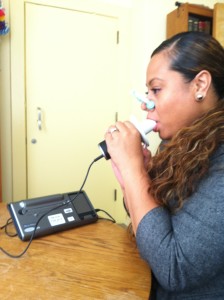By Lee Guion, MA, RRT, FAARC
Neurorespiratory Clinical Specialist
Getting the best results
Lung function testing, or spirometry, may cause anxiety, especially if it’s your first test or you’ve noticed changes in your breathing. You might be competitive by nature and will strain to do your very best. So staying relaxed during spirometry testing is a big challenge. Here are some tips I’ve learned over years of coaching pALS during spirometry testing for getting the most accurate results:
- Wear comfortable and loose-fitting clothing to clinic. If necessary, loosen bra straps and unbuckle belts, as they can compress the lungs or abdomen.
- Sit in a position that is most comfortable for you to breathe, either upright or leaning slightly back.
- Keep the mouthpiece firmly between your teeth and make a tight seal with your lips to avoid air leaks.
- Make sure your tongue does not block the mouthpiece. If you wear dentures, make sure they are secure.
- Take a couple of practice breaths before testing begins.
- When you take a big breath in, relax your abdominal muscles so your diaphragm has room to expand downward and your rib cage outward. It may help to place a hand over your lower abdomen so you can feel the outward movement.
- When forcefully exhaling, keep your upper chest open and your throat soft. Straining to push all the air out may cause you to bear down (as in a valsalva/closed glottis maneuver), reducing the flow of air or trapping air in your lungs. This action will sound like grunting, straining, or wheezing.
- Engage your abdominal muscles and intercostal muscles (between the ribs) to forcibly push air out. Resist the impulse to bend forward, which will compress the lungs and lessen volume.
- Exhale for at least 6 seconds. This is necessary for accurate results. Your tester will time and coach you during each test.
- Rest between each test. You will perform a minimum of three exhalations but perhaps more if there is a lot of variability between the test results.
- Thank yourself for all your hard work.
Your tester may have you repeat spirometry testing while you are lying on your back (supine) and compare the results to the ones obtained while sitting. Gravity assists in lung expansion when we are upright. We lose gravity’s benefit when supine. Comparing upright and supine spirometry test results helps physicians evaluate the strength of your diaphragm as it works without gravity’s help.

